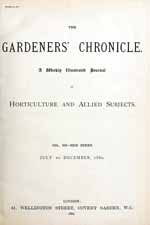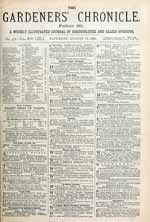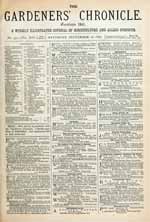No. 348. August 28, 1880. p. 273 |
(uncredited editor) in: The Gardeners' Chronicle No. 348. Vol. XIV. (new series), Saturday, August 28, 1880. p. 273 —— REPRODUCTION OF ZAMIOCULCAS LODDIGESII FROM ITS LEAFLETS.—Zamioculcas Loddigesii is remarkable among Araceæ in having a genuine pinnate leaf with articulated, deciduous leaflets. These leaflets exhibit, after falling, a singular amount of vital energy—a kind of energy common, it is true, to many other plants in some form or other, but displayed by this plant in a noteworthy manner. The leaflets are thick in texture, and fall away separately from the rachis. Mr. HILD, of the Kiel University Botanic Garden, as reported by Professor ENGLER, in his Jahrbücher (p. 189), observed that some fallen leaflets, which had not been removed at once, developed, in the course of a few days, a swelling at the basal end, which finally grew into al bulblet about half an inch in diameter. The thought naturally struck Mr. HILD to place them in the ground, where the bulblets soon formed two buds and around and beneath them rootlets. Whether the bulblets would have produced buds and roots if left lying on the surface of the ground is not certain, but it seems very probable. At the date of writing, Prof. ENGLER'S plants raised in this way were three months old. After placing the leaflets on which the bulblets were formed in the ground, the bulblets increased to more than an inch in diameter, and evolved buds and rootlets. The buds first develope some scaly leaves which are succeeded by a pinnate leaf bearing one pair of leaflets. Apart from its physiological bearings, this is an interesting phenomenon, a knowledge of which may be useful to the practical gardener.
|
|
No. 351. September 18, 1880. p. 375 |
R. J. Lynch in: The Gardeners' Chronicle No. 351. Vol. XIV. (new series), Saturday, September 18, 1880. p. 375 Reproduction of Zamioculcas Loddigesii from its Leaflets. At p. 273, in your issue of August 28, I find a note quoted of this occurrence in the Botanic Garden of Kiel University. I feel an interest, therefore, in saying that this method of propagation was made use of at Kew for purposes of distribution soon after the introduction of the plant. This, indeed, is the explanation of its being so soon and so widely distributed. Excellent plants were soon obtained in small pots fit for sending anywhere, and being of so much interest was soon, it is safe to say, in all the chief botanic gardens of the world. When the leaflets grow a large white callus is formed at the base, in shape like a young Gloxinia tuber, and from the top of which after a short time the shoot springs. The circumstance of discovering this vital energy I do not remember, though I believe, as under certain circumstances the leaves fall readily, that some were observed to grow in the bed on which the plants were standing. R. J. L.
|
|
|
this html version © 2009 Norbert Anderwald - All rights reserved |
||
November 3, 2009 |
last update: November 6, 2009 |


